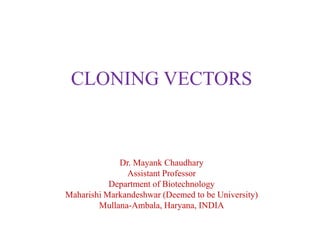
Cloning vectors
- 1. CLONING VECTORS Dr. Mayank Chaudhary Assistant Professor Department of Biotechnology Maharishi Markandeshwar (Deemed to be University) Mullana-Ambala, Haryana, INDIA
- 2. PLASMIDS • These are extra-chromosomal, double-stranded, circular DNA molecules capable of autonomous replication within bacterial cells. • Size of plasmids range from 1kb-250kb. • Episomes/Integrative Plasmids: Plasmids that replicate by integration into bacterial chromosomal DNA. • Copy number: Number of molecules of individual plasmid that is found in single bacterial cell. On the basis of copy no.: 1) Stringent: Have low copy no. per cell (1 or 2) 2) Relaxed: Present in multiple copies per cell.
- 4. • Plasmid Classification: 1) Fertility or F Plasmids: Conjugative plasmid carrying transfer gene (tra) and having the ability to form conjugation bridge (F pilus) with F- bacterium. Eg. F plasmid of E.coli. 2) Resistance or R Plasmids: Carry genes which give resistance to bacteria from one or more antibacterial agents. Eg. RP4 plasmid found in Pseudomonas. 3) Col Plasmids: Have genes that code for colicins (proteins that kill other bacteria). Eg. ColE1 of E.coli. 4) Degradative Plasmids: Allows host bacterium to metabolize unwanted molecules such as toluene and salicylic acid. Eg. TOL of Pseudomonas putida. 5) Virulence Plasmids: Confers pathogenicity to host bacteria. Eg. Ti plasmid of Agrobacterium tumefaciens. 6) Cryptic Plasmids: Do not have any effect on the phenotype of the cell carrying them.
- 5. pBR322 • Plasmids can have insert size of ≤15kb. • Nomenclature: • P: indicates that it is a plasmid • BR: identifies laboratory where it was constructed (stands for Bolivar and Rodriguez who investigated it) • 322: distinguishes it from other vectors developed in the same laboratory. • Useful Properties: Suitable size (4363 bp ‹ 10kb)- To avoid problems such as DNA breakage during purification. 2 marker genes (ampicillin and tetracycline resistant genes) High copy number
- 7. pUC • Nomenclature: • p: indicates plasmid • UC: University of California • Useful Properties: • Small size (2686 bp) • High copy numer • Contain lacZ sequence (easy identification through blue/white screening) • Ampicillin resistant marker gene
- 8. Bacteriophages • Viruses that infect bacteria. • Simple structure: Nucleic acid surrounded by protein coat (capsid). • Phage infection cycle: lytic or lysogenic
- 11. • Typical insert size for phage is 5-20kb. • Features of lambda DNA molecule: 1) Size of lambda DNA molecules is 49kb. 2) Gene clustering (genes performing related functions are grouped that allows switching on/off of genes as a group rather than individually. 3) DNA conformation: Linear DNA has two free ends with 12nt single- stranded stretch on either side. These single strands are complementary and can base pair to form circular, double-stranded molecule. Complementary single strands are called as sticky ends/cohesive ends. Also known as Cos sites. Function of Cos sites: 1) Allows circularization of linear DNA molecule injected into bacterial cell. 2) Acts as recognition sites for RE to separate out large number of DNA molecules formed through rolling circle mechanism.
- 13. • Types of vectors developed using Lambda genome: 1) Insertion Vectors 2) Replacement Vectors Insertion vectors: Foreign DNA is inserted into lambda genome without significant change of wild-type genome resulting int small insert size (upto 10kb).
- 14. • Replacement vectors: Stuffer fragment is replaced by foreign DNA resulting in insert size of 10-23kb.
- 16. Cosmid • Hybrid plasmid with bacterial ori sequence and cos sequences derived from lambda phage. • Within a cell, Cosmid replicates as a plasmid (Recombinant DNA is therefore obtained from colonies rather than plaques). • Contains gene for selection. • Insert size: 35-50 kb. • Widely used for synthesis of genomic libraries. • Example of Cosmids: pJB8 • Limitations of Cosmid vector: 1) Slower replication 2) Higher frequency of recombination 3) Unstability inside host (E.coli)
- 17. Phagemid • Cloning vectors that are hybrid of filamentous phage M13 and plasmids. • Components of Phagemid vector: 1) Origin of replication of plasmid 2) Intergenic region (IG) containing packaging signal for phage particle 3) Gene encoding phage coat protein 4) Selection marker 5) Restriction enzyme recognition sites • Commonly used for phage display technology (proteins are expressed as fusions to phage coat proteins and displayed on the viral surface) • Example: pEMBL • Advantages of Phagemids over Phage vectors: Higher carrying capacity, higher transformation efficiency and more stability.
- 19. Artificial chromosomes • These are DNA molecules assembled in-vitro that can function as natural chromosomes. Types: • BACs: Bacterial artificial chromosomes • YACs: Yeast artificial chromosomes • MACs: Mammalian artificial chromosomes • PACs: P1-derived artificial chromosomes
- 20. BACs Insert size: 100-300 kb • Components of BACs: 1) oriS, repE-F: for plasmid replication and regulation of copy number 2) parA and parB: To maintain low copy number and to avoid two F plasmids in single cell 3) Antibiotic resistance marker gene 4) lacZ gene for blue/white selection 5) T7 and Sp6 promoters for transcription of inserted genes Example: pBeloBAC11
- 21. YACs Insert size: 100-500 kb • YAC has sequences to exist as circular plasmid inside bacteria and as linear nuclear chromosome in yeast. • Components of YAC vectors: 1) E.coli origin of replication 2) Yeast origin of replication 3) Elements of eukaryotic yeast chromosome (centromere and telomere) 4) Selection markers for both the host • Can be used to express eukaryotic proteins that require post-translational modifications.
- 22. MACs Insert size: 100 kb-1 Mb • MACs also depend upon presence of centromeric, telomeric sequences and origin of DNA replication. • Two procedures for generation of MACs: 1) Telomere directed fragmentation of natural chromosomes. (eg. HAC from chromosome 21) 2) De novo assembly of cloned centromeric, telomeric and replication origins in-vitro. • MACs have application in gene therapy and eukaryotic protein expression.
- 23. REFERENCES 1) T.A. Brown. Gene Cloning and DNAAnalysis-An Introduction. Seventh Edition. 2) NPTEL notes (Module 1).